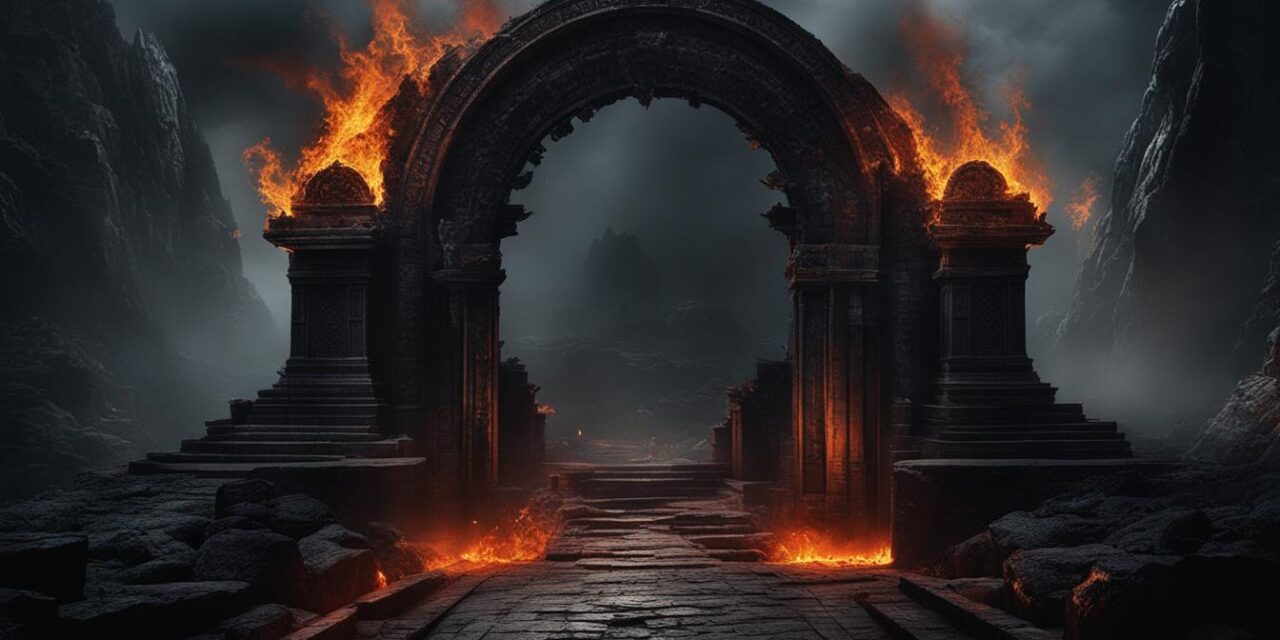Have you ever wondered why the concept of hell holds such a powerful grip on our collective imagination? It seems that no matter the time period or cultural background, the allure of eternal punishment has fascinated and intrigued us. From ancient religious texts to contemporary movies and music, the topic of hell permeates our society and continues to trend. So, what drives our fascination with hell? Let me share a story that sheds light on this cultural obsession.
Imagine you’re sitting around a campfire on a chilly autumn night. Shadows dance and flicker as the flames cast an eerie glow. Your friends start swapping ghost stories, each one becoming increasingly spine-chilling. As the night wears on, the conversation takes a darker turn, and someone brings up the topic of hell. Suddenly, the atmosphere changes, and everyone leans in, captivated by the discussion.
Ashley, a talented storyteller, begins to recount her personal experience visiting an old, abandoned asylum rumored to be haunted. The imposing building with its crumbling walls and broken windows set the perfect stage for a terrifying adventure. As she explored the depths of the dilapidated structure, Ashley discovered a hidden tunnel leading to a secret underground chamber. Heart pounding, she cautiously entered, only to be greeted by a bone-chilling sight.
The chamber was adorned with macabre paintings depicting scenes of unimaginable suffering, twisted bodies, and grotesque demons. The air thickened, and a sense of foreboding enveloped Ashley. It was as if she had caught a glimpse into the depths of hell itself. That experience left an indelible mark on her psyche and ignited a curiosity that would persist throughout her life.
As Ashley finishes her story, the group falls silent, their imaginations running wild. The allure of hell and its symbolism of punishment and fear lingers in the air, fueling their fascination. It’s a fascination that transcends that campfire, echoing through centuries of human history.
So, why are we so captivated by hell? Is it the fear of eternal punishment? The desire for justice? Or perhaps it’s the unknown that beckons us, the eternal quest for meaning and understanding in the face of mortality. Join me as we explore the origins of hell, its presence in religious texts, and its prominent role in popular culture. Together, let’s unravel the mystery behind our profound cultural obsession with eternal punishment.
Hell in Ancient Mythology and Literature
The concept of hell is not exclusive to Christianity. In ancient mythology and literature, various cultures depicted their own versions of the underworld, a realm of punishment and afterlife. From the Greek and Roman underworlds described in epic poems like the Odyssey and the Aeneid to ancient visualizations of hell in paintings and mosaics, the idea of a dark realm of punishment has been a recurring theme throughout history.
The origins of hell can be traced back to ancient civilizations, where it was believed to be a place where souls would go after death to face eternal torment for their sins. In Greek mythology, the underworld was known as Hades, ruled by the god of the same name. Roman mythology had a similar concept with the underworld ruled by Pluto.
In Greek mythology, the underworld was depicted as a gloomy and desolate place where the souls of the deceased would reside. It was divided into different sections, including Tartarus where the wicked were punished, Elysium where the heroes and righteous were rewarded, and the Asphodel Meadows for those who led ordinary lives.
Ancient visual representations of hell can be found in numerous works of art. Paintings and mosaics from ancient Rome often featured scenes depicting the punishment and torment of the damned. These depictions served as a reflection of the societies’ beliefs and fears surrounding the afterlife.
Hell in Greek and Roman Mythology
In Greek mythology, the concept of the underworld was crucial in understanding the afterlife. It was believed that upon death, souls would be led by Hermes to the entrance of the underworld, where they would be judged by the three-headed dog Cerberus before being assigned their place in the realm of Hades.
In Roman mythology, the underworld was known as the Realm of the Dead and was ruled by the god Pluto. Similar to Greek mythology, the concept of punishment and reward in the afterlife existed, with the wicked being sent to Tartarus and the virtuous being granted a place in the Elysian Fields.
Ancient Depictions of Hell
Ancient civilizations often used art as a medium to convey their perceptions of hell. Paintings and mosaics depicted scenes of punishment and torment, capturing the imagination and fears of the viewers. These vivid visualizations offered a glimpse into the ancient understanding of the afterlife and the consequences of one’s actions in the mortal realm.
| Hell in Ancient Mythology | Hell in Ancient Literature |
|---|---|
| A dark realm of punishment and afterlife | Greek and Roman underworlds described in epic poems like the Odyssey and the Aeneid |
| Believed to be a place where souls face eternal torment for their sins | Ancient visualizations of hell in paintings and mosaics |
| Depicted in various ancient cultures | Reflect the societies’ beliefs and fears surrounding the afterlife |
Through ancient mythology and literature, the concept of hell has been a prevalent theme, providing insights into the beliefs, fears, and moral values of different cultures. These depictions offer a glimpse into the origins of hell and the significance it held in understanding the mysteries of the afterlife.
Hell in Religious Texts
The Christian concept of hell is prominently depicted in religious texts, particularly the Bible. Both the Old and New Testaments contain numerous references to hell, describing it as a place of eternal punishment for the wicked. These scriptures play a significant role in shaping our understanding and fascination with the concept of eternal damnation.
Passages from the Bible, such as Isaiah 66:24, Matthew 25:46, and Revelation 20:14-15, vividly portray hell as a fiery and tormenting realm. These descriptions evoke a sense of fear and awe, capturing the imagination of believers and non-believers alike. The Christian concept of hell serves as a moral deterrent, emphasizing the consequences of sin and the importance of leading a righteous life.
“And they shall go forth, and look upon the carcasses of the men that have transgressed against me: for their worm shall not die, neither shall their fire be quenched; and they shall be an abhorring unto all flesh.” – Isaiah 66:24
It is noteworthy that the Bible’s depiction of hell is not uniform, and interpretations vary among different Christian denominations and theologians. Some emphasize the literal existence of hell as a place of eternal suffering, while others interpret it symbolically as a separation from God’s presence. Regardless of the specific interpretation, the concept of hell carries immense theological and moral significance within Christianity.
Biblical References to Hell
| Scripture | Description |
|---|---|
| Isaiah 66:24 | Describes hell as a place of eternal punishment and abhorrence. |
| Matthew 25:46 | Highlights the everlasting nature of punishment in hell and the promise of eternal life for the righteous. |
| Revelation 20:14-15 | Portrays hell as the lake of fire where the devil, death, and all those whose names are not written in the Book of Life will be cast for eternal punishment. |
The biblical references to hell serve as a reminder of the consequences of one’s actions and the need for repentance and redemption. They also contribute to the cultural fascination with hell, inspiring artistic and literary representations that further shape society’s perception of the afterlife.
Hell in Popular Culture
Hell has made its presence felt in popular culture, permeating various forms of entertainment. From movies and TV shows to music and art, hell has become a recurring theme that continues to captivate audiences worldwide.
Hell in Movies and TV Shows
Movies and TV shows have embraced the allure of hell, presenting imaginative and often chilling portrayals of this otherworldly realm. Films like “The Devil’s Advocate” and “Constantine” delve into the dark and supernatural aspects of hell, exploring the consequences of its inhabitants’ actions. Popular TV series like “Lucifer” and “The Good Place” have also taken on the concept of hell, offering unique perspectives on redemption, punishment, and the complex nature of morality.
Hell in Music
Musicians have long drawn inspiration from hell, infusing their lyrics and compositions with its symbolism. Hell serves as a metaphorical concept that allows artists to explore themes of inner struggles, temptation, and the duality of human nature. Artists like Johnny Cash in his legendary song “The Man Comes Around” and AC/DC with their iconic “Highway to Hell” have used hell as a dramatic backdrop to convey powerful messages and evoke intense emotions.
Hell Symbolism
Hell’s symbolism extends beyond movies and music. Visual artists, writers, and even designers often incorporate elements associated with hell in their creations. Dark and fiery motifs, demonic imagery, and gothic aesthetics frequently invoke the essence of hell to amplify emotions and provoke thought. By tapping into the symbolism of hell, creatives are able to convey a sense of danger, temptation, or transformation, capturing the attention of audiences and leaving a lasting impression.
Hell Hath No Fury: Gender, Disability, and the Invention of Damned Bodies
In her book Hell Hath No Fury, religion scholar Meghan Henning delves into the cultural and historical aspects of hell, with a specific focus on the treatment of gender and disability in early Christian literature. Henning’s thought-provoking analysis sheds light on the intersection of religion, gender, and disability in the invention and perception of damned bodies in hell.
According to Henning, early Christian visions of hell depicted the damned as inhabiting disabled, female, and imprisoned bodies, reflecting the social norms and biases of the time. This historical treatment of non-normative bodies in hell reveals the intertwined nature of misogyny and ableism in the concept of eternal punishment.
This examination of gender and disability in hell challenges traditional notions of punishment and raises questions about the historical portrayal of marginalized individuals in religious texts. By exploring how hell has been used as a tool to reinforce societal prejudices against women and people with disabilities, Henning prompts us to reevaluate our understanding of power dynamics and cultural biases embedded within religious narratives.
“Early Christian visions of hell reflected the fears and prejudices of the time, perpetuating the marginalization and dehumanization of non-normative bodies.” – Meghan Henning
Modern Perspectives and Implications
Henning’s research not only provides valuable insights into historical representations of gender and disability in hell but also prompts us to critically examine contemporary beliefs and representations. Understanding the historical context of these portrayals can help us challenge and dismantle the persisting misogynistic and ableist narratives that permeate our society.
By acknowledging the cultural and historical biases embedded in the concept of hell, we can begin to dismantle problematic perceptions and work towards a more inclusive and equitable society. Henning’s work invites us to question the ways in which religion and culture intersect to shape our understanding of gender, disability, and identity as a whole.
This thought-provoking image highlights the complexities and intersections of gender and disability in the concept of hell. It serves as a visual representation of the themes explored by Meghan Henning in her book, illustrating the historical treatment of non-normative bodies within religious narratives.
Conclusion
The fascination with eternal punishment in hell is a complex phenomenon that has intrigued humanity for centuries. It is deeply rooted in our religious beliefs, cultural symbolism, and historical biases. From ancient mythologies to modern popular culture, the concept of hell has been continuously reimagined and perpetuated, making it a trending topic that captures our collective consciousness.
Our cultural obsession with hell can be driven by various factors, such as fear, curiosity, and a desire for justice. The allure of the unknown and our eternal quest for meaning and understanding in the face of mortality fuel the enduring fascination with this realm of eternal punishment. Hell continues to captivate our imagination, ensuring its place as an ongoing topic of interest.
As long as the concept of hell remains prevalent in religious texts, literature, and entertainment, our fascination with it will persist. This cultural obsession with hell reflects our innate curiosity about the afterlife and our ongoing exploration of the complexities of good and evil. Whether we view it as a place of divine retribution or a metaphorical symbol, hell remains an intriguing subject that resonates with many.
In conclusion, our fascination with eternal punishment in hell reveals our collective interest in exploring the unknown, grappling with the concepts of good and evil, and seeking answers to profound existential questions. As our culture continues to evolve, our fascination with hell will likely endure, keeping it a trending topic that sparks discussion and reflection for years to come.
FAQ
Why are we fascinated with hell?
Where does the concept of hell originate?
What do religious texts say about hell?
How is hell portrayed in popular culture?
What does “Hell Hath No Fury” explore?
MORE SOURCES TO READ:
- https://hyperallergic.com/682691/why-the-hell-we-are-obsessed-with-hell/
- https://www.clatworthy.org/theology/hell-more-fun-than-heaven/
- https://iep.utm.edu/hell/
![]()











Recent Comments